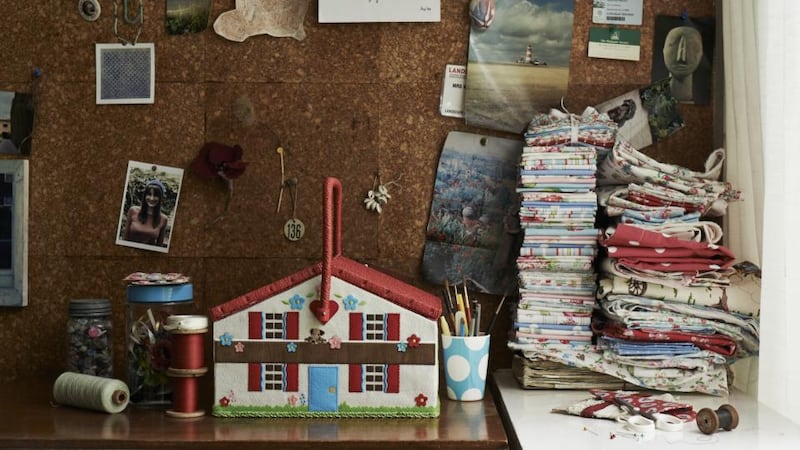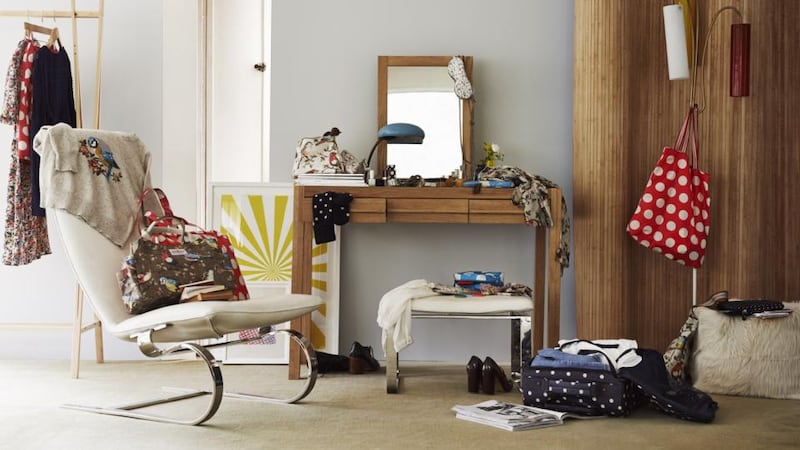'Remember these?" A woman holds up a neat 1970s-style sewing kit in the small Cath Kidston shop in London's Covent Garden. It is crowded in here: mainly with Japanese tourists, women who were children in the 1960s and 1970s, and younger women relishing retro as intro.
It is also crowded, in a systematic way, with floral wrap dresses in a wardrobe; rolls of bright, printed cotton and oilcloth leaning against a wall; trays of covetable impulse buys; household goods (from crockery to ironing boards) and stacks of stationery in starry, dotted and 1950s-style patterned fabrics.
Delight is the overriding emotion, emanating from evoked childhood memories, the fact that functional need not be boring, grey or white (something Apple computers also capitalised on) and that homewares can be witty and fun.


As a child Kidston played shops and as an adult she has made shops playful. "I liked the idea of earning money and my first 'shop' was a laurel bush using leaves for money," writes Kidston in her book Coming up Roses.
In fact her empire, which turns over more than £50 million (€58 million) a year, grew out of her life experiences. She grew up in a Georgian house in Hampshire, England, with two brothers and a sister (she and her sister spending much of their time in one wing with a nanny). Her father was in business – shipping – and when he died unexpectedly in his 50s her mother turned to business (renting out rooms in her home and sewing) to keep cash coming.
That desire to start earning meant Kidston eschewed university and went to London to work. There – like many of us who were in the city at the time – she trawled Kensington Market for loons (flared trousers – they were in at the time, okay?) and floral tea dresses. She loved Fiorucci's witty designs, shopped in Miss Selfridge (then a department in Selfridge's) and treasured-hunted in car-boot sales, accumulating vintage pieces that would later become the seed and core of her business.
Serendipitously, her day job was in interiors. She spent four years working for socialite and designer Nicky Haslam, accompanying him to meet many of his famous clients and being sent on her own, aged 25, to measure up Ava Gardner's windows for curtains. "It was the first time I'd really loved my job. It seemed so glamorous," says Kidston, whose cousin is fellow interiors queen, Kirstie Allsop.
Another of her interior design jobs was for record producer Hugh Padgham, whose work includes Phil Collins's In the Air Tonight. He's now her life partner, although she pointed out (on Desert Island Discs) that there was a gap of a four years between measuring up for his curtains and living with them as a backdrop.
Her first shop specialised in curtains. She set it up with a friend, Shona McKinney, off London’s King’s Road. “It was the late 1980s and swags and tails and really grand curtains were in vogue. And I had an idea for a shop that would be all things curtain-related; there wasn’t really another store specialising like that.”
But then things got both simpler and global. “Flicking through a magazine one day I saw photo of a bathroom that was so simple and uncluttered. I loved the old rose wallpaper on the side of the bath, the glossy paint on the big armoire. It summed up all the ideas I’d had about using English heritage designs and giving them a twist. It was my eureka moment!”
And that was when the Cath Kidston brand began, starting with a shop on a sidestreet in Notting Hill, selling vintage finds and some of her own designs. In her book she is helpfully honest about mistakes she made along the way and showing that great empires can be built on learning from “mistakes” or reconfiguring them into an advantage. When an order for 1,500m of floral gingham fabric arrived made up into duvets and pillowcases, far too many for her small shop, she cut them up and made them into cushions, aprons, washbags, bath hats, 1950s-style swimsuits and so on. “And so my first proper product collection was born . . . completely by accident!”
The idea of using vintage fabrics on unexpected household items rocketed. There have since been many imitators – roses and florals have grown to cover practically everything – but their failings are Kidston’s strength. Some of them are twee, something she avoids “Our signature look is colourful, cheerful, witty but never too fussy, too pretty or too twee.” She also only sells things that are useful.
Kidston and her long-time designer Gill Hicks don’t reproduce vintage prints exactly: they are redrawn in new colourways with additional motifs and patterns. For instance, in her seaside fabric she not only has the expected jaunty sailboats in materials of yore, there are also vast tankers sailing across the waves. “I think a Cath Kidston product is still recognised by the way the print is drawn (they are often still hand-drawn), the use of fresh colour and how the print is placed and used on a product.” And it is that mix of wittiness, quirkiness and surprise, along with a determination never to be in debt, that appear to be the fabric of her success.
It has not been all rosy though. When she was 37 she got breast cancer and was told by doctors it would be too risky to have children. Some years later a specialist said the advice was wrong but it was too late. She is grateful for the fact that she has known her stepdaughter Josie since she was a year old. She also admits tacitly that if she had had children she might never have grown the business and that, in some ways, the company filled the childless hole.
She acknowledges that hers is a “Marmite brand”: either loved or hated and used in moderation by devotees, but for those who enjoy the taste there is that delight in it.“That emotional connection we have with our customers, the ability to make them remember happy times,” says Kidston, “is one of the things I’m most proud of.”









